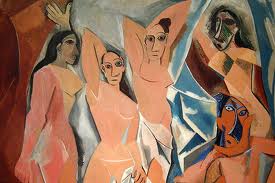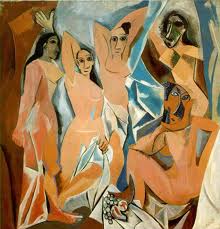Les Demoiselles d'Avignon
'Les Demoiselles d'Avignon' (The Young Ladies of Avignon) is a painting which is a mix of the styles of Cubism, Modernism and Primitivism. It was painted by the Spanish painter Pablo Picasso in 1907. Today it is considered to be one of the most important paintings of the 20th Century.
The Painting

'Les Demoiselles d'Avignon' is an oil painting on a canvas background and it measures 2.44 metres in height by 2.34 metres in width. The subject of the painting is a group of female prostitutes from a brothel, hanging around on a street in city of Barcelona.
The five ladies of the painting are painted as being nude. However the women do not seem very welcoming or attractive, but in fact appear rather aggressive and unfeminine. This is due to the odd, angular and disjointed depiction of the women in Picasso's early Cubist style. Two of the women appear to have mask-like faces, almost like an African tribal mask. These flat faces are painted in a Primitive style which shows a break from traditional western style painting. Although Picasso often denied the fact that these women's faces were influenced by African masks, it is clear that he made a revision to their original faces after having visited the 'Musée d'Ethnographie du Trocadéro' (Museum of Ethnography of Trocadero). In contrast, the other three women have more traditional looking faces, albeit still with a flat perspective.
At the bottom of the painting there is a table on which sits a collection of fruit. This is therefore a painting within a painting as the fruit appears more like a still-life. Surrounding the women and in the background are the curtains of the brothel which is one of the only ways to distinguish the depth in the picture as it is painted mainly in a two dimensional perspective.

'Les Demoiselles d'Avignon' contains a number of clear elements and influences from other famous painters and their works. In particular, Picasso was influenced by the Greek Mannerist painter, El Greco, who lived in Spain for the majority of his life. In fact, 'Les Demoiselles d'Avignon' resembles El Greco's painting 'Apertura del Quinto Sello' (The Opening of the Fifth Seal) in its motifs and stylistic elements. Other influential artists for this work include Cézanne and Gauguin.
History
'Les Demoiselles d'Avignon' has always been a controversial painting, but no more so than when it was first displayed. Even some of Picasso's own artist friends were not very convinced by the painting. When it was put on display in 1916 at an exhibition run by André Salmon, nine years after the painting had been completed; the name of the painting was changed. Picasso had called it 'Le Bordel d'Avignon' (The Brothel of Avignon) however Salmon felt this title would be too controversial and too shocking for the audience of the exhibition, and so he changed it to 'Les Demoiselles d'Avignon'.
At this time the painting was not fully appreciated as a masterpiece like it is today. The painting therefore stayed in Picasso's studio until André Breton pushed him to publish it. It was not until the 1920s that people began to realise the genius and revolutionary qualities of the painting.
The painting was sold to Jacques Doucet in 1924 for 25,000 francs but just a few months later, Doucet had the painting valued at around 250,000 to 300,000 francs. After Doucet's death, the painting was sold on to another private collector. 'Les Demoiselles d'Avignon' was then exhibited in 1937 at the Jacques Seligman and Co. Art Gallery in New York, USA. Later, the Museum of Modern Art bought the painting for the sum of 24,000 US dollars. The painting can still be viewed there today.
